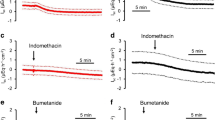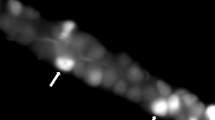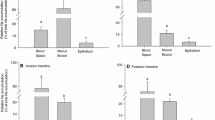Summary
The electrical properties of the basolateral membrane of rabbit descending colon were studied with microelectrode methods in conjunction with the polyene antibiotic nystatin. Two problems were examined: (i) the relative distribution of tight junctional, apical membrane and basolateral membrane resistances, and (ii) the ionic basis of the basolateral membrane potential. Intracellular K+ activity (K+) was measured using liquid ion exchanger microelectrodes ((K+)=76±2mm) and was found not to be in equilibrium with the basolateral membrane potential. In order to measure membrane resistances and to estimate the selective permeability of the basolateral membrane, the apical membrane was treated with nystatin and bathed with a K2SO4 Ringer's solution which was designed to mimic intracellular K+ composition. This procedure virtually eliminated the resistance and electromotive force of the apical membrane. Shunt resistance was calculated by two independent methods based on microelectrode and transepithelial measurements. Both methods produced similar results (R s =691±63 Ω cm2 and 770±247 Ω cm2, respectively). These findings indicate that the shunt has no significant selectivity, contrary to previous reports. Native apical membrane resistance was estimated as 705±123 V cm2 and basolateral membrane resistance was 95±14 V cm2.
To estimate basolateral membrane selectivity, the serosa was bathed in a NaCl Ringer's solution followed by a series of changes in which all or part of the Na+ was replaced by equimolar amounts of K+. From measures of bi-ionic potentials and conductance during these replacements, we calculated potassium permeability and selectivity ratios for the nystatin-treated colon by fitting these results to the constant field equations. By correcting for shunt conductance, it was then possible to estimate the selective permeability of the basolateral membrane alone. Selectivity estimates were as follows:P Na/P K=.08 andP Cl/P K=.07 (uncorrected for shunt) andP Na/P K=.04 andP Cl/P K=.06 (basolateral membrane alone).
In a second set of experiments, evidence for an electrogenic Na+ pump in the basolateral membrane is presented. A small ouabain-sensitive potential could be generated in the nystatin-treated colon in the absence of chemical or electrical gradients by mucosal, but not serosal, addition of NaCl. We conclude that this electrogenic pump may contribute to the basolateral membrane potential; however, the primary source of this potential is “passive”: specifically, a potassium gradient which is maintained by an “active” transport process.
An appendix compares the results of nystatin experiments to amiloride experiments which were conducted separately on the same tissues. The purpose of this comparison was to develop a comprehensive model of colonic transport. The analysis reveals a leak conductance in the apical membrane and the presence of an amiloride-insensitive conductance pathway.
Similar content being viewed by others
References
Carpenter, D.O., Alving, B. 1968. A contribution of an electrogenic Na+ pump in membrane potential ofAplysia neurons.J. Gen. Physiol. 52:1
Cass, A., Dalmark, M. 1973. Equilibrium dialysis of ions in nystatin-treated red cells.Nature New Biol. 244:47
Cass, A., Finkelstein, A., Krespi, V. 1970. The ion permeability induced in thin lipid membranes by polyene antibiotics nystatin and amphotericin B.J. Gen. Physiol. 50:100
Delamere, N.A., Duncan, G. 1977. A comparison of ion concentrations, potentials and conductances of amphibian, bovine and cephalopod lenses.J. Physiol. (London) 272:167
Feig, P.U., Wetzel, G.D., Frazier, H.S. 1977. Dependence of the driving force of the sodium pump on rate of transport.Am. J. Physiol. 232:F448
Frizzell, R.A. 1977. Active chloride secretion by rabbit colon: Calcium-dependent stimulation by ionophore A23187.J. Membrane Biol. 35:175
Frizzell, R.A., Koch, M.J., Schultz, S.G. 1976. Ion transport by rabbit colon. I. Active and passive components.J. Membrane Biol. 27:297
Frizzell, R.A., Turnheim, K. 1978. Ion transport by rabbit colon. II. Unidirectional sodium influx and the effects of amphotericin B and amiloride.J. Membrane Biol. 40:193
Hodgkin, A., Katz, B. 1949. The effect of sodium ions on the electrical activity of the giant axon of the squid.J. Physiol. (London) 108:37
Holz, R., Finkelstein, A. 1970. The water and electrolyte permeability induced in the lipid membrane by the polyene antibiotics nystatin and amphotericin B.J. Gen. Physiol. 56:125
Isaacson, L.C. 1977. Resolution of parameters in the equivalent circuit of the sodium transport mechanism across toad skin.J. Membrane Biol. 30:301
Lewis, S.A. 1977. A reinvestigation of the function of the mammalian urinary bladder.Am. J. Physiol. 232(3):F187
Lewis, S.A., Diamond, J.M. 1976. Na+ transport by rabbit urinary bladder, a tight epithelium.J. Membrane Biol. 28:1
Lewis, S.A., Eaton, D.C., Clausen, C., Diamond, J.M. 1977. Nystatin as a probe for investigating the electrical properties of a tight epithelium.J. Gen. Physiol. 70:427
Lewis, S.A., Eaton, D.C., Diamond, J.M. 1976. The mechanism of Na+ transport by rabbit urinary bladder.J. Membrane Biol. 28:41
Lewis, S.A., Wills, N.K., Eaton, D.C. 1978. Basolateral membrane potential of a tight epithelium: Ionic diffusion and electrogenic pumps.J. Membrane Biol. 41:117
Reuss, L. 1978. Mechanism of transepithelial hyperpolarization produced by amphotericin B inNecturus gall bladder.Biophys. J. 21:168a
Reuss, L., Finn, A.L. 1975. Electrical properties of the cellular transepithelial pathway inNecturus gallbladder. II. Ionic permeability of the apical cell membrane.J. Membrane Biol. 25:141
Russell, J.M., Eaton, D.C., Brodwick, M.S. 1977. Effects of nystatin on membrane conductance and internal ion activities inAplysia neurons.J. Membrane Biol. 37:137
Schultz, S.G., Frizzell, R.A., Nellans, H.N. 1977. Active sodium transport and the electrophysiology of rabbit colon.J. Membrane Biol. 33:351
Spenney, J.G., Shoemaker, R.L., Sachs, G. 1974. Microelectrode studies of fundic gastric mucosa: Cellular coupling and shunt conductance.J. Membrane Biol. 19:105.
Turnheim, K., Frizzell, R.A., Schultz, S.G. 1977. Effects of anions on amiloride-sensitive, active sodium transport across rabbit colon,in vitro.J. Membrane Biol. 37:63
Ussing, H.H., Erlij, D., Lassen, U. 1974. Transport pathways in biological membranes.Annu. Rev. Physiol. 36:14
Yonath, J., Civan, N.M. 1971. Determination of the driving force of the Na+ pump in toad bladder by means of vasopressin.J. Membrane Biol. 5:366
Author information
Authors and Affiliations
Rights and permissions
About this article
Cite this article
Wills, N.K., Lewis, S.A. & Eaton, D.C. Active and passive properties of rabbit descending colon: A microelectrode and nystatin study. J. Membrain Biol. 45, 81–108 (1979). https://doi.org/10.1007/BF01869296
Received:
Revised:
Issue Date:
DOI: https://doi.org/10.1007/BF01869296




